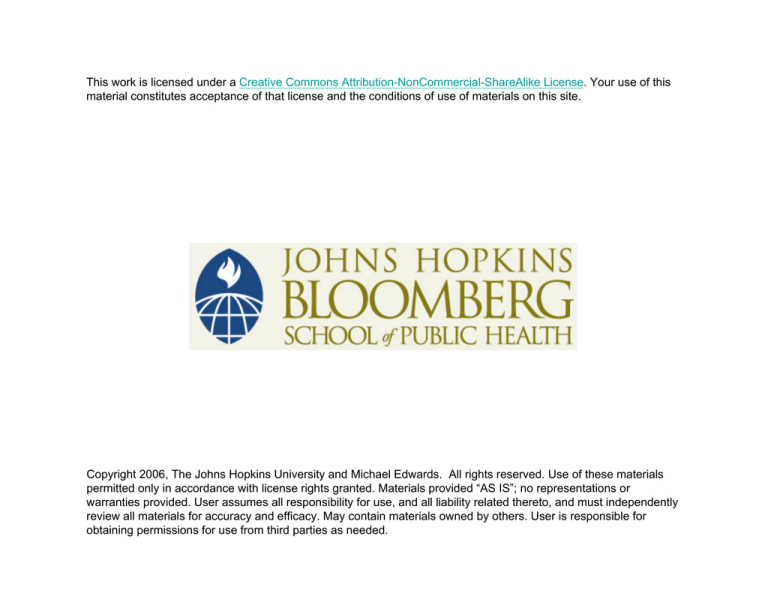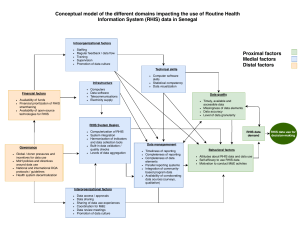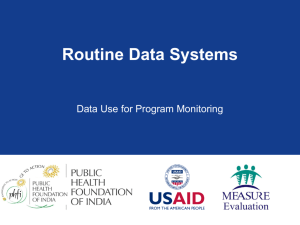
This work is licensed under a Creative Commons Attribution-NonCommercial-ShareAlike License. Your use of this
material constitutes acceptance of that license and the conditions of use of materials on this site.
Copyright 2006, The Johns Hopkins University and Michael Edwards. All rights reserved. Use of these materials
permitted only in accordance with license rights granted. Materials provided “AS IS”; no representations or
warranties provided. User assumes all responsibility for use, and all liability related thereto, and must independently
review all materials for accuracy and efficacy. May contain materials owned by others. User is responsible for
obtaining permissions for use from third parties as needed.
Routine Health Information Systems:
Concepts and Methods
Michael Edwards, PhD
Biostatistician/Senior Health Informatics Advisor
MEASURE Evaluation Project
John Snow, Inc.
email: medwards@jsi.com
Johns Hopkins Presentation, 2006
Outline of this presentation
• Routine Health Information Systems (RHIS) concepts
• PEPFAR (President’s Emergency Plan for AIDS
Relief)
• Analytical Framework for Understanding RHIS
Performance – The Prism Concept
• RHIS coordination and capacity building
• Analysis of RHIS data - Decision Support Systems
• Research Agenda
What do we mean by Routine HIS?
• Definition:
– Ongoing data collection of health status, health
interventions, and health resources
– Examples: facility-based service statistics, vital
events registration, community-based information
systems
• Role:
– District level and below: generate information in
support of planning and management of quality
health care services
– Integration between individual care and
community-based interventions and coordination
with other sectors
– National level: monitor performance and guide
policy (MDGs)
Common Problems
• RHIS inadequate to provide needed
information support
• Lots of (mostly irrelevant) data
• Data flow problems: under-reporting, missing
reports and lack of feedback
• Lack of “information culture”
RHIS concepts
•
•
•
•
Definitions
RHIS system components
RHIS and other data collection methods
RHIS and the health system
HIS = MIS = HMIS=RHIS=??
•
« … a system that provides specific information support to the
decision-making process at each level of an organization »
(Hurtubise, 1984)
•
How to deal with « Babelian » situation about the terms?
•
HIS = the overall (national) health information covering all data
collection methods (routine - non-routine)
•
Routine HIS = often called Facility-based HIS = often called HMIS
•
HMIS confuses people who think that disease surveillance is not
part of HMIS.
•
Just know what you are talking about.
Components of a Health Information System
Information Process
Indicators
Resources
Data Collection
Data Transmission
Management
Data Processing
Data Analysis
Information use for
Decision Making
Organizational
Rules
The ultimate goal is not to
gain information, but to
improve action.
HIS: DATA COLLECTION METHODS
hROUTINE DATA COLLECTION
hHealth unit based – Service Statistics
hCommunity based
hCivil registration and vital events
hSentinel reporting
hNON-ROUTINE DATA COLLECTION
hPopulation or health unit-based surveys
hPopulation census
hRapid assessment procedures (RAP)
hINFORMAL DATA COLLECTION
Surveys Database
(Macro)
HIV Sero-database
(BUCEN)
1. Surveillance
2. Surveys
Surveillance Data
Population-Based Surveys
Health Facility Surveys
3. HMIS: Facilitybased reporting
Country-level
DATA WAREHOUSE
Web-based reports
Results from HMIS/Program
Reporting & Targeted Evaluations
4. Program data:
Non-facility based
reporting
National Database/CRIS+
5. Targeted
Evaluations
Central
PEPFAR
Database
COP/Report
Commodities
Budget
USG/WHO/
Global Fund/
UNAIDS
HMIS and other EMERGENCY PLAN DATA SOURCES
Unfortunately...
yHealth information systems in most
(developing) countries are woefully
inadequate to provide the needed information
support ...
Why Routine Health
Information Systems?
• What is the role of routine health
information systems at district level?
– Evidence-based decision making
– More effective and efficient planning and
management
– Enable health system performance
– Contribute to improving health status
What is wrong with existing routine
health information systems?
yIrrelevance and poor quality of the data
collected
yFragmentation into “program- oriented”
information systems: duplication and waste
yCentralization of information management
without feedback to lower levels
yPoor and inadequately used health
information system infrastructure
As a result…
yPoor use of information by users at all levels:
care providers as well as managers
y“Block” between individual care and public
health information systems
yReliance on more expensive survey data
collection methods
Strategies to improve routine
health information systems
yPropose technically sound HIS
restructuring process
yFocus on district managed and
population-based routine information
systems
yContribute to the state of the art (SOTA)
on RHIS development: creation of
RHINO in 2001
HIS Design
• Your assessment should have identified areas to
work on.
• Sometimes a “top down” approach is not the
best.
• Often you need to work up from the foundation.
• Overall design should incorporate the ‘ultimate’
build out and allow for incremental building.
• Priorities for IT investments
• Stakeholder involvement
MEASURE Evaluation: Focus on district RHIS
PRIMARY
District Population
CATCHMENT AREA POPULATION
Patient/Clien
t contact
First level
care unit
SECONDARY
Referred
patients
District
Hospital
TERTIARY
Referred
patients
Regional
Hospital
Referred
patients
National
Hospital
University
Hospital
INDIVIDUAL
HEALTH UNIT
CARE
MANAGEMEET
MANANAGEMENT
Routine Health
Information
System
District
Health
Management
Team
Regional
Health Mgmt
Team
Ministry of
Health
Universities
Other Health
Institutions
SYSTEM
MANAGEMENT
HEALTH CARE SERVICES
HEALTH SERVICES SYSTEM
HEALTH SYSTEM
NON-ROUTINE DATA
COLLECTION METHODS
HEALTH
CARE LEVEL
DISTRICT
LEVEL
REGIONAL
LEVEL
NATIONAL
LEVEL
OTHER SECTORS:
-Environment
-Civil Administr.
-Transport
-Education
Data collection
• Golden rules
– Keep data collection instruments AS SIMPLE as
possible
– Involve users in the design
– Standardize definitions and procedures and
include them in a user ’s manual
– Develop an appropriate incentive structure for
data use
– Train care providers as data collectors and data
users
• Paper-based versus computerized
• Facility-based versus patient-retained
Data aggregation
• Options:
– (1) using individual data from clinical
records; or
– (2) using cumulative data from registers
or tally sheets
• Purpose
– reporting to higher level
– periodic self-evaluation (e.g. monitor
facility-based counseling and testing
rates)
Data transmission
• Within the individual health care system
– To promote continuity of care (between care
services and lab; between first level and referral
level)
• From health units to system management
level
– Periodic reporting respecting existing channels
(facility --> district --> regional --> national)
– Appropriate use of newer communication
technologies (Internet, e-mail, PDAs, smart cards,
etc.)
Data processing and analysis
• Increasingly with use of computer
technology
• Development of customized
applications for data processing and
analysis
• Emergency Plan: opportunity to build
capacity in data processing/analysis at
district level
Five principles to improve use of
information
• Active participation in system design
leads to ownership/relevance of
information
• Production of quality and timely data
• Performance-based management systems
• Communication between data and action
people
• Data presentation and communication
customized for users at all levels
Successful HIS reform
requires:
yPreliminary
yHigh
stakeholders analysis
level leadership: find a “saint”
yBroad
consensus-building of users
in the design stage
yUseful
information products early in
the process
Proposed methods and tools
• Direct HIS reform efforts towards development
of district level managed integrated RHIS
• Develop comprehensive RHIS strategic
planning tool (including stakeholders analysis;
behavioral/systemic/technical assessment)
• Develop web-based decision support systems
and data warehouses
• Develop longitudinal medical record systems
for HIV/AIDS (both paper-based/computerized)
• Pilot test newer ICT tools: PDAs, cell phones,
smart cards, GPS/GIS
A Sample of MEASURE Evaluation RHIS Activities
(Monitoring and Evaluation to Assess and Use Results)
• Technical assistance to countries: RHIS
strengthening (e.g. Morocco, Eritrea, Haiti, Nigeria,
Ivory Coast, Kenya)
• RHINO: birth and early development
– Potomac, South Africa, Thailand workshops
– Listserv (rhino@lists.jsi.com): advocacy and
communication
– RHINO Website (http://www.rhinonet.org)
• PEPFAR (President’s Emergency Plan for AIDS
Relief:
– Managing MIS subgroup
– Country assessments
– Coordination and consensus building
– Technical assistance to countries
– System strengthening
Lessons learned
• Need for quality and timely information
is the highest at district level and below
• Availability of quality information is not a
sufficient condition to use it for action
• Immense need for in-country capacity
building, again district level and below
• PEPFAR: shift to ART calls for
patient/client management tool
development
PEPFAR
(President’s Emergency Plan for AIDS Relief)
• A multi-agency $15 billion U.S. initiative to provide HIV
care, treatment, and prevention services to HIV affected
populations in the developing world
• Two, Seven, Ten Goals: Treat 2 million infected people
with anti-retroviral therapy, prevent 7 million new
infections, and care for 10 million people infected by HIV
or affected by it.
• HMIS committee – draws expertise from USAID, CDC,
HRSA, Census Bureau, DoD, and Peace Corps
– Includes technical expertise from private partners
– Works closely with counterparts at WHO and UNAIDS
PEPFAR
Strategic Information Key Components
• HIV/AIDS surveillance
• Population-based bio-behavioral surveys
and facility surveys
• Health Management Information Systems
for facility-based reporting
• Program-level monitoring and reporting
(non-facility based)
• Targeted evaluation studies
Place of facility-based HIS in
Emergency Plan
• The facility-based health information system (RHIS) is
one of main sources of information for M&E of the
Emergency Plan
• Facility-based HIS in most recipient countries are weak
and their strengthening is a key strategy for M&E of the
Emergency Plan
• Strengthening of HIS is not a quick fix: it needs a broad
system approach to be successful.
• The same is obviously true for the introduction of
Information Communication Technology (ICT)
Examples of Information Systems
Supporting HIV Programs
•
•
•
•
•
•
•
•
•
Pharmacy management
Laboratory management
Logistics/supply chain management
Program monitoring (OVC, palliative care)
Facility-based patients systems (e.g., ART)
Vital statistics registries
Facility-based surveys (e.g., ANC clinics)
Population-based surveys
National notifiable disease reporting systems
Emergency Plan: HIS design and
implementation challenges (1)
• How to provide immediate assistance to
focus countries in order to report core
indicators?
• How to strike a balance between shortterm results and long-term objectives of
capacity-building?
• How to link the Emergency Plan
supported MIS to the National HIS?
• How to address the country-specific
context of facility-based information
systems?
Emergency Plan: HIS design and
implementation challenges (2)
• How to address the lack of HIS human
resource capacity?
• How to ensure the production of quality
data by the HIS?
• How to ensure confidentiality of HIV/AIDS
information?
• How to address the complexity of
multiple-source funding?
Rationale for integration of HIV/AIDS
information in existing (facility-based) RHIS
• Integration with other individual health interventions
– prenatal/postnatal and obstetrical care
– STI, tuberculosis
• Integration with other sectors and communities
– school health, orphan care, home care etc.
• Cost-effectiveness
– avoid duplication in data collection and continuity of
care
Role of facility-based RHIS in the
Emergency Plan
• Production of data on quality and
continuity of patient care (ART - PMTCT)
• Production of data on laboratory results
• Production of data on resources: human
resources, drugs, equipment, costs
• Facilitating integration of HIV/AIDS
interventions with other interventions: TB,
MCH, orphan care, etc.
It’s More than Forms, Software
• Need to provide a complete solution
– Forms
– Software
– Documentation
– Training
– Support
– Evaluation
– Continuous Improvements
Competing Needs / Tensions
No absolute “best” approach
Tensions
Short Term vertical
solutions
Simpler, faster, more
immediate impact
Long-term building
of the HIS
More complex, longer
term investment
• Both approaches must support the national
system.
– We do not help ourselves by assuming our need for
quality, timely data supercedes other in-country
needs.
Tensions
Custom forms
More effective
operations
National forms
Faster roll-out, allows
more comparability
• DOTS (TB treatment) as an example?
• Less discussion has been around paper
innovations, but perhaps more is needed in
the future.
Tensions
Custom software built
from scratch
More effective
operations
Standardized
solutions
Faster roll-out, efficiencies
in development,
operations and support
• Investigating existing solutions takes time;
programmers want to program
• Need to find the middle ground with solutions that
can be locally customized but centrally supported
Tensions
Emergency
Implementation
Sustainable
Solutions
Damn the torpedoes
(and the cost)
Don’t implement solutions
that require expensive
technology and HR
• Deal with the emergency and then work on
sustainability?
• Nearing end of second of five years on the
Emergency Plan
Introducing an Analytical Framework for
Understanding Performance of Routine
Health Information Systems in Developing
Countries
PRISM Framework for Understanding
Health Information System (HIS) Performance
Inputs
HIS assessment,
HIS strategies
HIS interventions
Organizational/ Environmental
Determinants
Information culture, structure, roles &
responsibilities, resources
Desired Outcomes
= HIS performance
•good quality information
•appropriate use of information
Improved Health System
Performance
Improved Health
Outcomes
Technical
Determinants
Data quality,
system design, IT
Behavioral
determinants
Knowledge/ skills, attitudes,
values, motivation
What is good HIS performance?
• Production of good quality data
• Continued use of health data for improving
health system operations and health status.
What influences quality and use?
·Standard indicators
·Data collection forms
·Appropriate IT
·Data presentation
·Trained people
Technical
factors
What influences quality and use?
·Resources
·Structure of the
health system
·Roles, and
responsibilities
·Organizational
culture
System and
environment
factors
What influences quality and use?
·Motivation
·Attitudes and values
·Confidence
·Sense of
responsibility
Behavioral
factors
Applying the analytic framework
• Needs assessment: change the way we analyze
problems and see opportunities
• Strategies and interventions: attacking the three
sets of determinants
• Expanded partnerships to better address
demand-use continuum: health, planning,
financing ministries, NGOs, private sector
• Capacity building for sustained HIS performance
• TA: involving a broader range of professionals in
including OD and behavioral sciences .
Strategic approach :
The Data Demand - Use Continuum
Source: MEASURE Evaluation/USAID
RHIS Coordination
• RHINO (Routine Health Information NetwOrk):
– building a sustainable network of RHIS
professionals
– Workshops, Presentations, Listserve, On-line
Forums, RHINO Register and Bibliography
http://www.rhinonet.org
Health Metrics Network
• Establish national coordinating mechanism - MOH, Bureau of
Statistics, research & academic bodies, disease-specific
programmes
• Select essential indicators and develop integrated database – Data
warehouse
• Develop national health information system plan; better planning and
coordination of household surveys
• Develop health information system components; sample registration
that includes causes of death; avoid less cost-effective methods such
as maternal mortality surveys
• Enhance synthesis and use of data for decision-making (linking
inputs and outcomes) by combining data from all sources and linking
to budgets and expenditure.
• Support Health Statistics Resource Centre (software library, PDF
electronic library).
Capacity building
• Routine Health Information System course on
district RHIS design and implementation (South
Africa, 2005, Mexico, 2006)
• Adding HIS module to the existing M&E
curriculum with focus on use of information
• Provide TA on RHIS strengthening in selected
countries, particularly in PEPFAR countries
Analysis of RHIS data
•
•
•
•
•
•
•
•
•
Summary tables
Listing reports
Time trend graphs
Regional comparisons graphs
Geographic Information Systems (GIS)
Pivot tables - OLAP (online analytic processing)
Data mining
Data Warehousing
Decision Support Systems
What is a Decision Support System (DSS)?
– A computerized application allowing health
managers to visualize health indicators and data
elements collected by the Routine Health
Information System in graphical and geographical
presentations
– Based on the principle that COMPARISON is one
the most powerful analytical methods:
•
•
•
•
spatial: by health facility, district, province etc.
time: trends by week, month, year, etc.
indicators: between inputs and outputs
benchmark: expected versus achieved
Why a Decision Support System (DSS)?
– To allow health managers with limited data
analysis skills to better interpret aggregate
information from the RHIS
– To enable health managers to more rapidly
and efficiently prepare their data for
analysis and use for decision making
– Well suited for health managers at
national, regional, district levels and below
Decision-Support System
Retrospective
SQL
Reports, charts,
and graphs
OLAP
Visualization
Statistics
Data Source
User
Data Mining
Models
Descriptive/Prospective
Results: Producing quality data in
Morocco
• Intervention: Restructuring MCH/FP facilitybased information system
• Before RHIS scaling-up, the only
contraceptive prevalence rates available to
the MOH were national estimates from DHS,
every 5 years
• After scaling-up, calculations from RHIS data
provided the needed annual district and
national level CPR estimates
Results: Improved use of info for
decision making in Niger
• Intervention: Restructure infectious diseases
reporting system
• Before scaling-up, meningitis vaccines and
drugs were distributed equally among the
districts
• After scaling-up, vaccines and drug were
distributed in proportion to the meningitis
attack rate by district
• Improved presentation of outbreak
distribution was used by MOH to convince
donors to supply needed vaccines (4.5 million
doses)
The Meningitis Belt in Sub-Saharan Africa
Source: United Nations Country Team in Ethiopia (UNCT)
Weekly Meningitis Incident Cases,
1986 to 1996
Data Source: DSNIS/SG/MSP. Image Source: USAID.
Weekly Meningitis Incident Cases,
November 1994 to July 1995
Mass Vaccination
Data Source: DSNIS/SG/MSP. Image Source: USAID.
Data Source: DSNIS/SG/MSP. Image Source: USAID.
Monthly Meningitis Attack Rates
December 1994
February,
1995
January, 1995
March, 1995
0 to 5
5 to 15
15 to 100 Cases per
100 to 500 100,000
Results: Improved use of info for
decision making in Eritrea
• Intervention: general restructuring of the facilitybased RHIS
• Before scaling-up to improved RHIS, vaccine stock
outs went unreported
• After scaling-up, vaccine stock outs could be
monitored monthly, and the relationship between
stock outs and children vaccinated could be tracked
• Evidence of elevated stock out percentage alerted
MOH to request additional vaccines from donors
BCG Stock-outs: Effect on Children Vaccinated
Some Examples of
Decision Support Systems (DSS)
• Niger 1995
– DOS-based dBASE with Clipper and dGE
Graphics enhancements
• Morocco 1999, Eritrea 2000, Haiti 2001 and
Niger 2004, Nigeria 2005, others
– Microsoft Access based with Active-X Object
development tools (Graphics Server and Map
Objects LT
• Future Systems
– Web-based, with Visual Studio.NET and Graphics
Server.NET
– Web-based with Open Source solutions (PHP)
Some results of Decision Support
Systems (DSS)
– Widely appreciated by district health managers as
a planning and programming tool for health
activities in their districts.
– The district managers have “ownership” of the
data, and have higher motivation to insure the
data is of good quality.
– More emphasis is needed on the development of
an “information culture”, in which there is more
motivation and incentives for managers to use
data for decision-making (use of info workshops)
Future Directions for RHIS
• Development of Web-based systems across multiple
platforms (Windows/Linux…, .NET/Open Source…)
• Use of Mobile Computers/PDA’s/Cell phones
• Use of Data Warehousing and Data Mining techniques
• Use of Data Visualization and Business Intelligence
techniques
• Use of Database synchronization techniques
• Development of Patient-based systems
• Development of User Defined, Customizable Systems
Proposed Research Agenda (1)
• How can we measure the impact of
integrated district RHIS on health system
performance and health outcomes?
• What should be integrated and what not, and
at what level?
• Develop a “generic” list of district level
indicators as well as guidelines on how to
develop such a list
• Research on validity and reliability of RHIS going beyond technical aspects - looking at
behavioral aspects around use of information
Proposed Research Agenda (2)
• How to better link routine service statistics to
non-routine data collection
• What is the relationship between information
presentation and use?
• How to involve communities in managing
RHIS?
• Role of GIS technology in spatial analysis and
health system planning
Websites
•
MEASURE Evaluation Website:
http://www.cpc.unc.edu/measure
• Middle Earth MOH Demo:
http://snisnet.net/DSSDemoInstallFiles.zip
Kenya HIV/AIDS PEPFARProgram Monitoring Website:
http://snisnet.net/KePMS.php
• Biostatistics and Epidemiology Website:
http://www.jsi.com/measure/biostat.htm
• RHINONet:
http://rhinonet.org
• Health Metrics Network:
http://www.who.int/healthmetrics/
• DHS Stat Mapper:
http://statmapper.mapsherpa.com/




